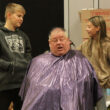Sean C. Morgan
The weather is wet.
Fire season is finished.
The burn ban has ended.
Fire danger is low.
Ironically, the biggest fire of the season on the Oregon Department of Forestry Sweet Home Unit happened after the official end of fire season.
“We’re there,” said Craig Pettinger, acting Sweet Home unit forester. We’re done. We have closed fire season. Backyard burning is open, as you can tell if you drive through town.”
The burn ban ended at 8 a.m. on Oct. 16. Fire season ended the same day.
Pettinger expected that slash burning would probably start this week.
The Willamette National Forest also announced fire danger was low and no fire season restrictions remained in effect.
Last week, the Sweet Home Unit had a run up Courtney Creek Drive, Pettinger said, but the fire didn’t amount to anything.
The biggest fire of the season, on Thursday, burned 16.5 acres east of Mallard Creek Golf Course, Pettinger said. The fire started when a debris burn got away while no one was watching it. Lebanon Fire Department provided engines and a tender to assist the Sweet Home Unit.
The fire, reported at about 4:30 p.m., was out within an hour, Pettinger said. The grass fire reached timber and shade and pretty much put itself out.
The Sweet Home Unit had a few firefighters on duty putting things away for the season when the call came in, Pettinger said.
All but two seasonal firefighters finished working last week, he said. Two remain on this week to winterize equipment.
Overall, the season was slow, with 66 fire calls, Pettinger said.
“It was slow to start,” Pettinger said. The weather was wet late and didn’t really dry out until about September. Then the weather turned hot and dry, with more than 100 days of no significant rain.
The problem with a late season is when it extends into hunting season, Pettinger said. With more people in the woods, there will be more problems since most fires are caused by humans. At the same time, the seasonal firefighter crew shrinks as school starts.
Most area landowners had closed or restricted access to their property as the fire danger started spiking at the end of September and beginning of October.
Some are still closed, Pettinger said, but others have started opening.
Hunters should call individual landowners for closure information. Two of the largest in the Sweet Home area are Cascade Timber Consulting at (541) 367-2111 and Weyerhaeuser at (888) 741-5403.Visit oregon.gov./ODF/pages/fire/corporate_closure.aspx for more phone numbers.
Sweet Home Unit Forest Protection Supervisor Chad Calderwood said slash burning will probably begin this week.
Forest owners will use fire to remove logging slash from their lands, creating space for tree planting and controls competing vegetation.
Oregon’s Smoke Management Plan enables landowners to use such burns, though they must minimize the intrusion of smoke into populated areas.
“We’re really concerned about the fuels that are going to be burned as well as expected wind and weather conditions, and proximity to populated areas we’re trying to protect,” said Nick Yonker, Oregon Department of Forestry’s meteorology manager.
During the prescribed burning season, staff meteorologists monitor weather and wind conditions hourly to gauge the optimum timing for burns to occur.
When a burning request comes in, they search for a window in time when the smoke is likely to rise up and away from nearby communities.
Before allowing a burn, they also consider cumulative impacts. If several area landowners want to burn, ODF may stagger the permits to limit the quantity of smoke. In western Oregon where native Douglas fir is the most commercially desirable tree species, prescribed burning boosts replanting success.
Shade-intolerant Douglas fir seedlings need a lot of sunlight so that they can thrive and eventually overtop surrounding vegetation.
In 2011, prescribed forest burns were conducted on 161,154 acres in Oregon. The 10-year average is 154,163 acres burned annually.
The U.S. Forest Service had meadow restoration burns scheduled this fall for 124 acres on Browder Ridge, 150 acres on Echo Mountain and 30 acres in the Lodgepole Flats area, but spokeswoman Jennifer Velez said the sudden arrival of rain doused that effort after five acres were burned at Lodgepole.
“It rained us out of the window for successful burning,” she said.




